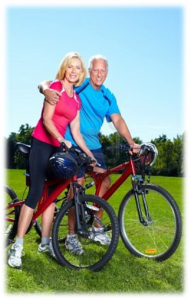 Knee Osteoarthritis is a common type of arthritis that often occurs in older people, but can affect younger people, as well. Osteoarthritis of the knee is a degenerative disease that occurs when the flexible, sponge-like tissue between joints wears down. When this tissue wears down, joints no longer have padding between them and bone rubs on bone causing extreme pain. Osteoarthritis can occur in hands, the lower back area, wrists, hips, the neck, and in the knees. Quite a lot of people think that the only resolution to Knee Osteoarthritis is to take it easy on using the knees, but that is actually not true. Exercise in small, monitored doses is commonly recommended by doctors as the first approach to treating Knee Osteoarthritis.
Knee Osteoarthritis is a common type of arthritis that often occurs in older people, but can affect younger people, as well. Osteoarthritis of the knee is a degenerative disease that occurs when the flexible, sponge-like tissue between joints wears down. When this tissue wears down, joints no longer have padding between them and bone rubs on bone causing extreme pain. Osteoarthritis can occur in hands, the lower back area, wrists, hips, the neck, and in the knees. Quite a lot of people think that the only resolution to Knee Osteoarthritis is to take it easy on using the knees, but that is actually not true. Exercise in small, monitored doses is commonly recommended by doctors as the first approach to treating Knee Osteoarthritis.
Dr. Stacie Grossfeld of Orthopaedic Specialists in Louisville, KY recommends three types of exercise to help patients with knee osteoarthritis. The three exercises that she recommends include: flexibility exercises, resistance exercises, and cardiovascular exercises. Follow along to learn more about each type of recommended exercise.
Flexibility Exercises for Knee Osteoarthritis
Flexibility exercises include stretching of the neck, upper body, lower body, and back, upper arm raises, and yoga. These types of exercise are very good for easing stiff joints and if the exercises focus on the knees then they will help relieve tension and pain caused by Knee Osteoarthritis. Dr. Stacie Grossfeld recommends that patients suffering from Knee Osteoarthritis complete their stretching exercises in the morning. When stretching is performed soon after waking up, your body is loosened up for the rest of the day and can make moving through it much easier. If joint stiffness is extremely bad in the morning, Dr. Grossfeld recommends performing flexibility exercises in warm bath water.
Resistance Exercises for Knee Osteoarthritis
Resistance exercises are important because not only do they help to ease arthritis pain, but they also help to build muscle back around the arthritic joints. Building muscle back helps to absorb shock in the knees and protects the joints from further injury. There are two types of resistance exercise: isometric and isotonic. Isometric exercises are typically the easier resistance exercise for patients with Knee Osteoarthritis because the joint angle and muscle length stay the same. Isometric exercises include: plans, push ups, wall sits, quads, and squat holds. In contrast, isotonic exercises maintain equal muscle tone while the muscle length shortens and lengthens during exercise. Isotonic exercise are mainly used to strengthen muscles and Dr. Grossfeld recommends sticking to isometric for improving joint flexibility.
Cardiovascular Exercises for Knee Osteoarthritis
Cardiovascular exercises use large groups of muscle while simultaneously raising your heart rate. Dr. Grossfeld highly recommends that patients with Knee Osteoarthritis looking to partake in cardio fitness try water aerobics or cycling – either indoor or outdoor. Both of these forms of cardiovascular exercise are highly effective, but low impact on joints. This ensures that patients will get the exercise they need to rebuild joint health and not hurt themselves further. Dr. Grossfeld also recommends visiting the website of The National Arthritis Foundation and using it as a resource for exercise DVDs.
If exercise doesn’t seem to be helping, Dr. Grossfeld recommends a referral to a local physical therapist. Physical therapy can be helpful, especially for patients who like personalized instructions and the ability to focus on maintaining technique through fewer exercises. If you feel like you are suffering from Knee Osteoarthritis with older age or as a younger person, contact Orthopaedic Specialists today and make an appointment with Dr. Stacie Grossfeld.

Leave a Reply
You must be logged in to post a comment.